Why
I-73 Has Not Been Built in Ohio Yet
Introduction
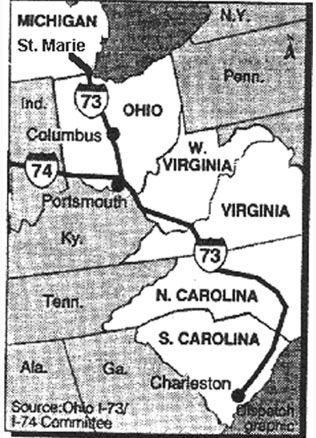 Transportation
is geography, but transportation can be political as well. You
have land use issues, development concerns, and problems of political
chain of command. These problems are evident when concerning the
building of interstate freeways. You have federal officials mandating
its building, state officials scrambling to find funding for it,
and local leaders debating whether or not to go along with this
idea. Limited access, divided highways are one way to alleviate
traffic problems, but no one wants that solution near them. These
people's defense will include that their farmland is the best,
their woods are the most scenic, or that they had moved from the
"city" and did not want to go back to it. These circumstances
helped to shape the debate about Interstate 73 in Delaware County,
Ohio
Transportation
is geography, but transportation can be political as well. You
have land use issues, development concerns, and problems of political
chain of command. These problems are evident when concerning the
building of interstate freeways. You have federal officials mandating
its building, state officials scrambling to find funding for it,
and local leaders debating whether or not to go along with this
idea. Limited access, divided highways are one way to alleviate
traffic problems, but no one wants that solution near them. These
people's defense will include that their farmland is the best,
their woods are the most scenic, or that they had moved from the
"city" and did not want to go back to it. These circumstances
helped to shape the debate about Interstate 73 in Delaware County,
Ohio
I want to show 4 points in this paper. How I-73 came about and
it's history in Central Ohio. How the process for choosing a routing
for I-73 proceeded and doomed it to failure. Why the public never
was entirely behind the I-73 project. Finally, how funding for
the project was blundered away by one state government department
that has delayed the construction for now. Between 1991 and 1996,
plans were organized for an interstate freeway to go north-south
through Ohio. Those plans have yet to be put into action, in Ohio,
due to two factors; the state has never been able to get favorable
public opinion to back it; and the lack of funds in the state
of Ohio to build it. The focus of most of the discussion about
this freeway concerns the routing of I-73 in Delaware County,
Ohio. It is there that the need for a new freeway is greatest,
but the protest against it was the strongest as well. Why has
Interstate 73 yet to be built in Ohio?
History
Interstate 73 was first proposed in 1991 as part of The Intermodal
Surface Transportation Efficiency Act of 1991 (ISTEA). ISTEA would
have created a "National Highway System." This would
be a United States Congress established system of highways of
national significance, as compared to the original system of freeways
established with section 7 of the Federal-Aid Highway Act of 1944
. One of the routes designated in the 1991 bill was a Great Lakes
to Mid Atlantic Corridor. It would connect Detroit, Toledo, Columbus,
Huntington, Bluefield, Winston-Salem, and Charleston South Carolina.
This routing was given the numeral designation I-73. For the Ohio
portion, I-73 was to follow US 23 from Toledo to Portsmouth and
US 52 from Portsmouth to Chesapeake where it would go into West
Virginia. The routing of I-73 seemed fairly easy to do everywhere
in the state of Ohio, except in Delaware, Franklin, and Pickaway
Counties. In that area lay one of 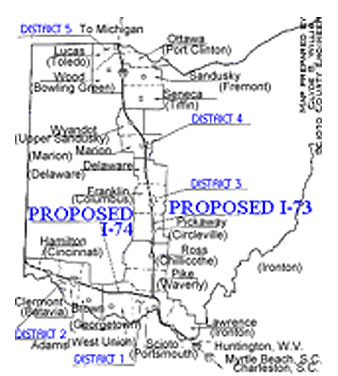 the major difficulties in getting I-73 from paper to
concrete and asphalt.
the major difficulties in getting I-73 from paper to
concrete and asphalt.
In a case of lucky foreshadowing, in 1990 (then) Governor George
Voinovich had approved expanding the Ohio Turnpike Commission's
authority to allow it to fund other highway projects, other than
the current Ohio Turnpike. This gave Ohio a "backdoor"
approach for highway funding if the Ohio Department of Transportation
(ODOT) did not have enough funds to properly plan or construct
any new highways. By the end of 1993 Governor Voinovich had given
approval for the Ohio Turnpike Commission (OTC) to do a feasibility
study for the proposed I-73 in Ohio. For the next three years
I-73 would be an OTC project with ODOT having no part in planning
it. This would ultimately affect the future of the project.
Two years after the US Congress had designated it for construction,
I-73 first came to light for much of the public in late 1993 with
the announcement that the OTC would do a feasibility study of
it. The preliminary idea for routing I-73 in Delaware County was
to have it go south along US 23, from Marion County, to between
the south end of Delaware Reservoir and the north end of Delaware
city limits. From there I-73 would branch off to the east then
south going around NE Delaware to US 36 east. I-73 would go along
US 36 east to I-71, where it would leave US 36 and multiplex with
I-71 into Columbus. The state of Ohio did have a committee that
worked on the routing of the I-73 corridor. They did however also
asked for a local preference as to where I-73 should be built.
At that time though, no one had done any traffic routing studies
for the freeway. So due to a lack of empirical backing to help
select a route the answer from the local Delaware committee at
that time was essentially, 'We don't know. Give us some numbers
to help us choose.'
Over the course of six months between progress reports, development
plans in the northeast section of Columbus were quickly beginning
to interfere with the 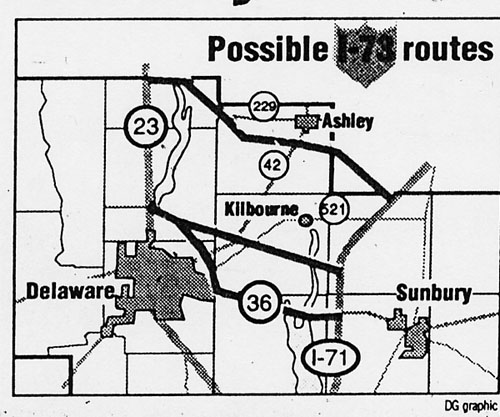 proposals.
With the advent of the Polaris Amphitheater and the (then) new
Bank One headquarters in Southern Delaware County and development
starting on Leslie Wexner's Easton, the added traffic that I-73
would bring to the freeways of that area was a concern for local
planners. Various people and organizations brought forth debate,
alternatives, and suggestions as to the routing and necessity
of I-73. One idea was the proposed building of another outerbelt
around Columbus. There were also proposed routes going directly
south from Delaware to I-270 using US 23 or SR 315, or going southwest
along US 42, from Delaware, to US 33 then back to I-270 in Dublin.
Still, none of these suggestions were under any sort of official
consideration or study yet (thus no maps were made of these ideas).
proposals.
With the advent of the Polaris Amphitheater and the (then) new
Bank One headquarters in Southern Delaware County and development
starting on Leslie Wexner's Easton, the added traffic that I-73
would bring to the freeways of that area was a concern for local
planners. Various people and organizations brought forth debate,
alternatives, and suggestions as to the routing and necessity
of I-73. One idea was the proposed building of another outerbelt
around Columbus. There were also proposed routes going directly
south from Delaware to I-270 using US 23 or SR 315, or going southwest
along US 42, from Delaware, to US 33 then back to I-270 in Dublin.
Still, none of these suggestions were under any sort of official
consideration or study yet (thus no maps were made of these ideas).
In spite of a lack of actual studies, in 1994 the first stated
estimates for I-73, from the Ohio Turnpike Commission, were two
billion dollars if it was all built from scratch, with possibly
several hundred million being deducted if I-73 could overlap existing
limited access highways. Allan Johnson, of the OTC, also came
out with a time frame for construction of the freeway. He said
a decision to build or scrap the project would come in late 1995
or early 1996. The design work would take another two years, and
construction would start in 1997. The OTC even went as far as
to say that the Delaware section would be built first with Johnson
saying, "...I think that could provide some of the most beneficial
things soonest." However, Delaware officials stated that
they were having difficulty in contacting members of the OTC and
were becoming impatient over this lack of communication.
Several months later, attitudes improved with the knowledge that
a feasibility study was underway and would be completed in March
of 1995. With that study, an official cost and alignment for I-73
would be known as well . It was soon after this that the first
letter to the editor of the Delaware paper concerning I-73 was
published. In it was a theme that would be heard many times over
the following two years. There were no good routes. Any route
would force people and businesses to relocate, thus creating more
problems than solutions, and not to mention encouraging the population
boom in Delaware County.
Process Begins
On March 16, 1995, the I-73 debate began in earnest. That was
the date on which the first proposed corridors for I-73 in and
around Columbus were publicly announced. Eight different alternatives
for routing I-73 though Delaware county were mapped out, and included
were several more involving the surrounding 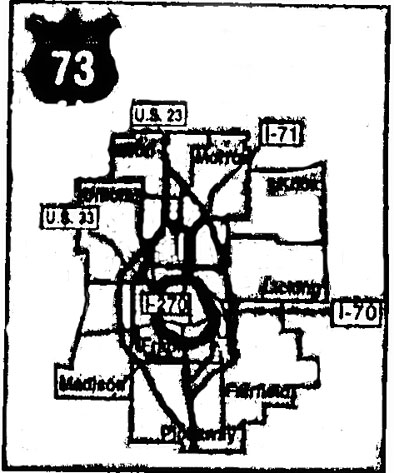 counties. Cost estimates for the route
between Circleville and Marion, which would go through Delaware
County, ranged from two hundred sixty-one million dollars to six
hundred seventy-seven million dollars, pending on I-73's routing
and how much of the current road system would be used.
counties. Cost estimates for the route
between Circleville and Marion, which would go through Delaware
County, ranged from two hundred sixty-one million dollars to six
hundred seventy-seven million dollars, pending on I-73's routing
and how much of the current road system would be used.
When the local officials looked at the plans, they were skeptical
that I-73 would help to alleviate any transportation problems.
Their main concern was lightening the traffic load on US 23, south
of Delaware. None of them felt that any route that branched off
from US 23, north of Delaware, would help with their traffic problems.
If they could get I-73 to go around south and west of Delaware
however, it could ease traffic access to the industrial park in
the SW portion and help diffuse traffic concerns on the NW side
as well. However, the routing of I-73 to the west of Delaware
would affect an avigational easement needed for expansion of the
local airport's main runway to five thousand feet. It could also
have possibly taken out a city park in the northwest end of Delaware
as well . When one local resident asked about regulations protecting
environmental features making I-73 feasible or even thinkable,
an OTC member responded, "If it isn't, we're going to have
gridlock, a parking lot between Delaware and Columbus. Wetlands
can be "mitigated," but it's expensive... I hope we
don't bankrupt the country with regulations like that." The
question became how does a state official, based in Cleveland,
know more about local traffic than the Delaware county and city
officials do. Showing all this "concern" without any
studies done showed I-73 as a top-down project being forced upon
the citizenry.
Public Reaction
The citizenry came out in force. To say the least, the general
public's view was extremely negative. Regularly, any public meeting
concerning I-73 in Delaware had the most attendees in that series
of meetings. Surprisingly, despite the public view, OTC members
were constantly stating publicly that they were pleased with the
large turnouts in Delaware. However, the OTC's single minded focus
was fairly evident in one statement after the first public showing
of the I-73 plans. James Brennan, of the OTC, theorized that most
visitors were "positive" about the I-73 proposal, and
many would like construction to start immediately. Maybe yes,
maybe no. Stated comments from the public at large contrasted
with that view. "We fought really hard to keep the dam out
... and now we're going to have to fight the highway." "We
did not build out there to be two miles from the highway. 71 is
close enough. We moved out here to be in the country."
So the sides were drawn. State officials wanted the I-73 corridor,
but were never forthcoming in releasing informational details
to the local officials. Local officials were divided over this
project. Some saw it as possibly helping Delaware's transportation
concerns, others saw it as someone else's idea being forced down
their throat and that it wouldn't help the county, or the city.
Delaware officials viewed I-73 rather oddly. They always talked
about it in a local sense, never expanding their boundaries past
the state borders, or mentioning that it was federally mandated
to be built as part of a bigger system. The public's reaction
was unsure. They saw the need for it, but no one wanted the route
running near their area.
The first group to come out against a routing of I-73 were residents
in Brown Township in Delaware County in April of 1995. This group
was mostly farmers who did not want to give up their land. They
saw a routing of I-73 through their area as causing them in particular
more problems than it would solve. They did not want to sacrifice
farm land, homes, and local businesses that would cause "economic
detriment to township residents." Their first meeting, where
their opposition was formed, drew thirty-five people. Their second
meeting drew over a hundred people. Their tactics were to get
county officials to support their protests, search for other groups
against I-73, and continue to write letters to politicians who
could influence the project.
How the OTC Bowed Out
Meanwhile, at this same time, the OTC decided to increase the
tolls on the Ohio Turnpike eighty percent. Their reasoning was
to help pay for widening the turnpike to three lanes in each direction
the entire length of the turnpike and for replacement of all sixteen
service plazas along the turnpike. There was no mentioning of
new highways or I-73 specifically when they did this. The toll
hike raised eyebrows and suspicions among state politicians and
others however.
The OTC got into a bad habit of giving out varying estimates on
their projects. They borrowed twenty-four million to pay for three
new interchanges in 1994, and those interchanges showed up again
the following year being funded by the proposed toll hike. Over
the course of the summer of '95, the OTC had published estimates
on the cost of expanding the turnpike rise seventeen percent.
When asked where the money from the year before went, Turnpike
Executive Director Allen Johnson said, "It's been used for
other projects," but Johnson could not say specifically where
the money went. "I can't (tell you) right off the top of
my head. We have so many projects under way," he told the
Cleveland Plain Dealer. The financial records of the OTC at that
time showed that they had $106.7 million dollars on hand and more
in investments that could cover much of the costs of the current
turnpike expansion, without having to raise tolls.
This was a red flag to the state's Congressional Transportation
Committees. The Ohio House produced a bill that would limit the
OTC to only a ten percent increase in its tolls by July 1st of
that year, and all other increases would have to be brought in
front of public hearings and the legislature would have a committee
to oversee the OTC. One state representative tried to block the
use of OTC funds for I-73, but his proposal was negated. State
Senator Scott Oelslager soon after then brought out a proposal
that would end the OTC's involvement with I-73, and any other
highway project that wasn't connected to the current Ohio Turnpike.
His bill would have let the OTC finish it's study of I-73 (everyone
agreed that there was no sense in stopping mid-stream, and forcing
someone else to start over sometime in the future), then it would
be out. Oelslager's stated reasoning was to limit authority of
the governor on transportation needs by keeping the OTC out of
ODOT's work (a complete opposite of Voinovich's intentions when
he authorized the OTC's involvement in the I-73 project). By January
of 1996, the Ohio Turnpike Commission conceded to these pressures
and decide to bow out of the I-73 project, after the study was
completed. Possible construction was to be declared an Ohio Department
of Transportation future project. However ODOT had no funding
for construction of the freeway for the appreciable future, so
there was no sensible time frame.
Final Decision
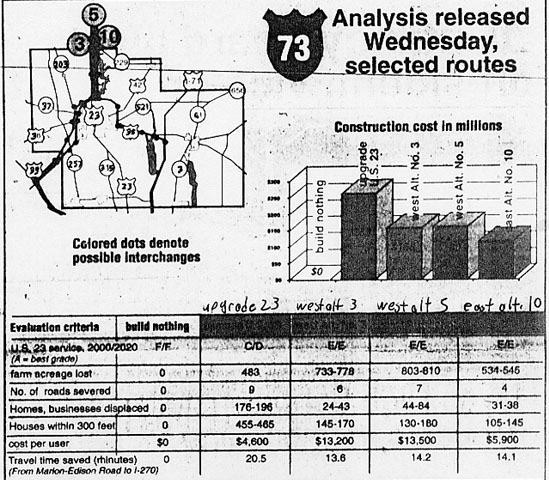 Meanwhile,
the local I-73 committee worked on choosing a proposed route.
With the protests coming largely from the eastern half of Delaware
County, officials looked to the western half for a solution for
I-73 . Citizens there caught on quickly and protested the highway
going through their area. Due to that, the committee crossed off
the western routes and looked at a central and southern route.
Again, people protested the freeway coming through their neighborhood.
That sent the committee back to the original plan for I-73. The
original plan would have I-73 go along US 23 to near Delaware,
then bypass the city to the North and east to US 36, then go east
to I-71 to go south to Columbus. It would cost the least to build
for ODOT. It would take up the least amount of farmland, housing,
businesses, and it would affect the fewest number of roads. This
routing would do the least harm for everyone involved.
Meanwhile,
the local I-73 committee worked on choosing a proposed route.
With the protests coming largely from the eastern half of Delaware
County, officials looked to the western half for a solution for
I-73 . Citizens there caught on quickly and protested the highway
going through their area. Due to that, the committee crossed off
the western routes and looked at a central and southern route.
Again, people protested the freeway coming through their neighborhood.
That sent the committee back to the original plan for I-73. The
original plan would have I-73 go along US 23 to near Delaware,
then bypass the city to the North and east to US 36, then go east
to I-71 to go south to Columbus. It would cost the least to build
for ODOT. It would take up the least amount of farmland, housing,
businesses, and it would affect the fewest number of roads. This
routing would do the least harm for everyone involved.
Interestingly it wasn't the most direct or the quickest route,
and traffic study results were mixed. There were arguments for
all the traffic to stay on US 23, but that would lead to massive
congestion that no highway(s) could cure on the approach to I-270.
Some even went as so far as to state that the bypass would be
so problematic to traffic in southern Delaware County, that it
wasn't even worth being built. Some believed the bypass in itself
would create more traffic and become a congested future issue.
Finally, there remained the rest who thought the bypass would
be just fine.
On April 24, 1996 after much consternation and teeth gnashing
the Northeast Delaware by-pass option was accepted as the routing
of I-73 through Delaware County. Delaware City officials and others
from outside Delaware County supported the plan. However in opposition
to the city, county officials did not care for the final routing,
citing that it was no solution to any of the current problems
with traffic in Southern Delaware County. Further more, the public
was up in arms, denouncing the decision. Interestingly, all became
quiet the issue not long after.
With I-73 falling under the auspices of ODOT, lack of funding
has kept the building of this highway quiet for four years now,
and for who knows how much longer. Even a member of ODOT came
out and, proclaimed that the latest status of Interstate 73, at
least in reference to the proposed linking of U.S. 23 with Interstate
71 across central Delaware County is, "dead. I don't know
how else to say it ... Those are political realities ... Basically,
people said they didn't want it."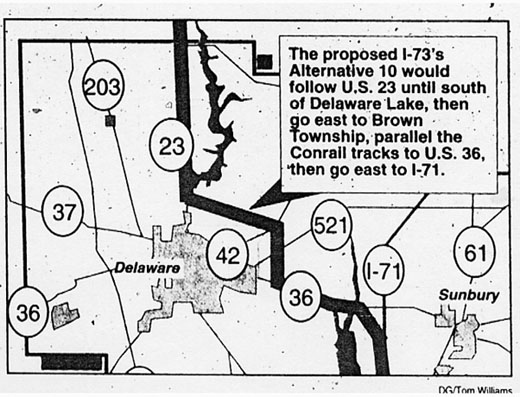
Conclusion
Where did the various proposals for I-73 go wrong? The Ohio
Turnpike Commission mishandled public and political communication
and thus funding for construction of I-73 was indefinitely postponed.
The inability of OTC and other local planners to have a proposal
that could solve some of Delaware's transportation problems in
an economic fashion caused local officials to disagree on the
freeway. The city of Delaware backed the I-73 plan. Delaware County
officials held their opinion till the end, but eventually came
out against I-73. Their indecision went parallel with the mood
of Delaware County citizens, who were opposed to any proposed
route that would affect them personally, but were supportive as
long as it was someone else's backyard. An analogy for the citizens
would be that they were not able to see the forest for the trees.
These people only cared about themselves and for the present.
It is that kind of thinking that doomed I-73. Eventually I-73
will be built through Ohio and Delaware County, just that the
problems described here have only postponed the inevitable from
happening.
Sources
Untill I can figure out how to add footnotes along the way,
the sources for this paper are as follows: Frank Gerlach-I-73/74
corridor webpage, 1997. Richard Weingroff. Delaware Gazette. Toledo
Blade. Allen Johnson (OTC director in 1994). Unknown OTC member
at a Delaware meeting. Cleveland Plain Dealer.
Ray
Lorello.
This paper was originally written in the Spring of 2000 for
Urban Political Geography (Geog 660) taught by Kevin
Cox at Ohio State University. This paper was slightly
revised in March, 2001 for the American
Association of Geographers National Conference.
Originally
linked to Roadfan.com on October 1, 2001/ Remade on August 6,
2003
Questions and comments concerning this paper can be sent to
Sandor Gulyas
Return to the I-73 in Ohio page.
 Transportation
is geography, but transportation can be political as well. You
have land use issues, development concerns, and problems of political
chain of command. These problems are evident when concerning the
building of interstate freeways. You have federal officials mandating
its building, state officials scrambling to find funding for it,
and local leaders debating whether or not to go along with this
idea. Limited access, divided highways are one way to alleviate
traffic problems, but no one wants that solution near them. These
people's defense will include that their farmland is the best,
their woods are the most scenic, or that they had moved from the
"city" and did not want to go back to it. These circumstances
helped to shape the debate about Interstate 73 in Delaware County,
Ohio
Transportation
is geography, but transportation can be political as well. You
have land use issues, development concerns, and problems of political
chain of command. These problems are evident when concerning the
building of interstate freeways. You have federal officials mandating
its building, state officials scrambling to find funding for it,
and local leaders debating whether or not to go along with this
idea. Limited access, divided highways are one way to alleviate
traffic problems, but no one wants that solution near them. These
people's defense will include that their farmland is the best,
their woods are the most scenic, or that they had moved from the
"city" and did not want to go back to it. These circumstances
helped to shape the debate about Interstate 73 in Delaware County,
Ohio the major difficulties in getting I-73 from paper to
concrete and asphalt.
the major difficulties in getting I-73 from paper to
concrete and asphalt. proposals.
With the advent of the Polaris Amphitheater and the (then) new
Bank One headquarters in Southern Delaware County and development
starting on Leslie Wexner's Easton, the added traffic that I-73
would bring to the freeways of that area was a concern for local
planners. Various people and organizations brought forth debate,
alternatives, and suggestions as to the routing and necessity
of I-73. One idea was the proposed building of another outerbelt
around Columbus. There were also proposed routes going directly
south from Delaware to I-270 using US 23 or SR 315, or going southwest
along US 42, from Delaware, to US 33 then back to I-270 in Dublin.
Still, none of these suggestions were under any sort of official
consideration or study yet (thus no maps were made of these ideas).
proposals.
With the advent of the Polaris Amphitheater and the (then) new
Bank One headquarters in Southern Delaware County and development
starting on Leslie Wexner's Easton, the added traffic that I-73
would bring to the freeways of that area was a concern for local
planners. Various people and organizations brought forth debate,
alternatives, and suggestions as to the routing and necessity
of I-73. One idea was the proposed building of another outerbelt
around Columbus. There were also proposed routes going directly
south from Delaware to I-270 using US 23 or SR 315, or going southwest
along US 42, from Delaware, to US 33 then back to I-270 in Dublin.
Still, none of these suggestions were under any sort of official
consideration or study yet (thus no maps were made of these ideas). counties. Cost estimates for the route
between Circleville and Marion, which would go through Delaware
County, ranged from two hundred sixty-one million dollars to six
hundred seventy-seven million dollars, pending on I-73's routing
and how much of the current road system would be used.
counties. Cost estimates for the route
between Circleville and Marion, which would go through Delaware
County, ranged from two hundred sixty-one million dollars to six
hundred seventy-seven million dollars, pending on I-73's routing
and how much of the current road system would be used.  Meanwhile,
the local I-73 committee worked on choosing a proposed route.
With the protests coming largely from the eastern half of Delaware
County, officials looked to the western half for a solution for
I-73 . Citizens there caught on quickly and protested the highway
going through their area. Due to that, the committee crossed off
the western routes and looked at a central and southern route.
Again, people protested the freeway coming through their neighborhood.
That sent the committee back to the original plan for I-73. The
original plan would have I-73 go along US 23 to near Delaware,
then bypass the city to the North and east to US 36, then go east
to I-71 to go south to Columbus. It would cost the least to build
for ODOT. It would take up the least amount of farmland, housing,
businesses, and it would affect the fewest number of roads. This
routing would do the least harm for everyone involved.
Meanwhile,
the local I-73 committee worked on choosing a proposed route.
With the protests coming largely from the eastern half of Delaware
County, officials looked to the western half for a solution for
I-73 . Citizens there caught on quickly and protested the highway
going through their area. Due to that, the committee crossed off
the western routes and looked at a central and southern route.
Again, people protested the freeway coming through their neighborhood.
That sent the committee back to the original plan for I-73. The
original plan would have I-73 go along US 23 to near Delaware,
then bypass the city to the North and east to US 36, then go east
to I-71 to go south to Columbus. It would cost the least to build
for ODOT. It would take up the least amount of farmland, housing,
businesses, and it would affect the fewest number of roads. This
routing would do the least harm for everyone involved.